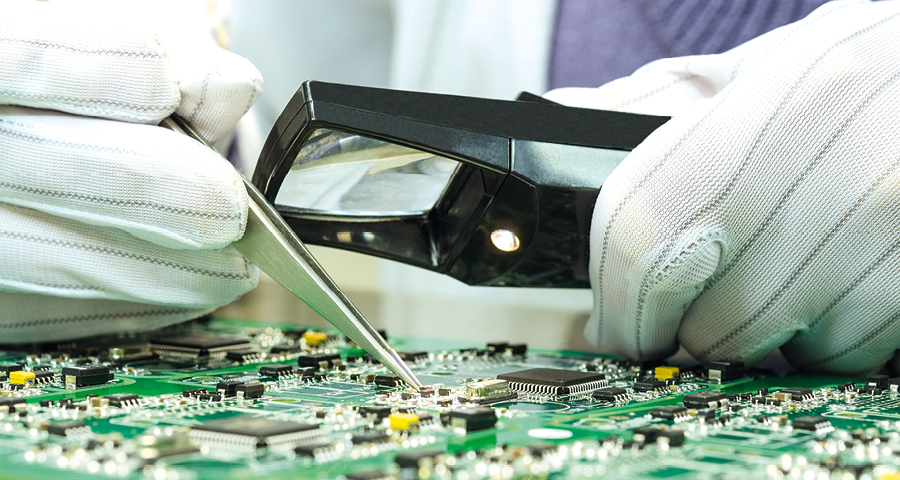
New applications driving the demand for PCBs
September 11, 2019
Growth and demand in the printed circuit board (PCB) industry continue and research indicates no sign of slowing down over the course of the next 5 years. The drive towards new and specific demand is identified in this blog, along with the capabilities of C-MAC SMT in how appeasing demand and delivering innovative solutions are at the forefront of business strategy.
What’s behind PCB demand?
PCBs are used when producing electronic circuits – that’s the simplest way to look at it. And these PCBs and circuits are the foundation for anything and everything electronic.
The demand can be easily connected to continued technological developments. PCB design and manufacture depend entirely on the requirements of any given electric circuit and is normally used in all electrical and electronics equipment – the simple reason behind why it has remained so popular. The move towards a reliance on electrical engineering over more traditional mechanical engineering is a loud signal identifying that the electronics industry can begin to gear up for an increase in PCB demand.
It isn’t unrealistic to imagine that circuit boards are going to be an integral facet within every vertical market as electrification and digitalisation remain the focus for businesses staying abreast of technological innovation of its products and services.
There is however, one particular area of importance when considering the market growth and that is the Internet of Things (IoT).
The Internet of Things (IoT) and PCB demand
You can’t escape the impact that the internet and its ongoing usage increases has on demand and should be considered a core driver. More specifically, the Internet of Things (IoT) is fundamental to growth and demand.
Often described as the fourth industrial revolution, if reports are to be believed, then we could be witnessing at least 26 billion devices connected to the internet by 2020. As specialists in PCB and electronic design and assembly, C-MAC SMT are fully aware of both the opportunity and challenges that this brings. The role a PCB designer will play in the world of Smart Homes, Smart Cars and Smart Cities, along with connected machinery and Smart factories will be critical.

We’re certain to see more electronics and communication parts in devices, leading to big increases in PCB requirements. Acting as the platforms on which connections and ICs to other electronic apparatus get installed, PCBs serve as the brains of these electrical devices.
IoT challenges for PCB suppliers
This market development doesn’t come without its challenges. However, the challenges are exciting for businesses like C-MAC SMT. Customers will likely be requiring innovative solutions that utilise every inch of layout space on a PCB and newer packaging technologies will be necessary to keep things smarter, slimmer and with smaller footprint.
PCB suppliers like C-MAC SMT will be considering an even closer working relationship with product designers. It’s going to be more important than ever before to get every stakeholder on the same page at the initial design stages. Flexible prototyping services will become critical.

C-MAC SMT PCB prototyping services
To further reduce manufacturing complications, ensure the highest quality products and speed up time to market, C-MAC SMT offer a rapid prototyping service.
Before any given design hits mass manufacture, dedicated and experienced C-MAC SMT PCB manufacturers will liaise with its specialist PCB designers, along with the necessary customer delegates and stakeholders to work together and look at all aspects of production, including sourcing components, reducing associated lead times and manufacturing testing. So, by the time a product reaches the manufacturing stage, all potential challenges have been overcome.

Furthermore, material challenges are likely to arise as requirements stretch beyond traditional manufacturing techniques. In the age of IoT, circuitry needs to be flexible and also embedded within other materials. Materials like plastic, flexi-rigid copper, and even mesh will have to be ‘worked out’ from a design and manufacture perspective.
C-MAC SMT have close connections with research, industrial design and academic bodies through its membership with the Manufacturing Assembly Network (MAN Group) and are actively part of the IoT, digitalisation and electrification conversations trending in the industry. This positions C-MAC SMT extremely well when considering any potential PCB requirement both now and in the future.

MAN Group
The Man Group provides complete engineering and manufacturing solutions through the collaboration of world-class knowledge, expertise and technology.
This network of manufacturing companies is designed to share technical excellence in mechanical, electrical and electronic engineering processes.
The group provides a non-competitive environment for member companies to share best practice and create a stronger, combined force when tendering for contracts.
Benefits of using MAN:
- Access to eight world class manufacturing facilities
- Access to research led innovation to develop new products, processes and services
- Experience of working across over 20 different industries
- Security of supply and supply chain rationalisation
- Added value manufacturing processes and design solutions
- Quality accreditations and all main customer approvals

Connected vehicles further increase PCB demand
The adoption of PCBs in electric vehicles and those connected and fully equipped with both wired and wireless technologies will also continue to drive PCB demand and design innovation. With such technology, drivers can unlock their vehicles, check their electric battery status, start climate control systems remotely and track their cars using smartphones.
PCBs will play a more significant role in the production and running of cars and other areas of vehicle electrification. As user demand for additional energy savings and better performance increases, so too does the need for more sophisticated PCB solutions. PCBs will play an important role in power conditioning, battery performance and voltage conversion.
It won’t just be the vehicles themselves that will rely heavily on PCBs, the infrastructure to support them will be requiring the same amount of attention from PCB manufacturers. The development of reliable charging stations (for example) require multiple PCB solutions as they assist in automated systems that both charge and include the inbuilt facility to make card and contactless payments.

Again, this doesn’t come without its challenges – PCB designers are faced with new problems. One of the biggest challenges is designing and manufacturing PCB solutions that can power and improve electric vehicles within the conditions that they perform under. The use of heat sinks, fans and spreaders are used traditionally to cope with a large heat output which these vehicles are likely to produce, but they can’t be adopted in electric vehicles. Instead, PCB designers and manufacturers have had to find solutions that offer higher levels of thermal performance, moving away from standard resin boards and experimenting with new materials.
PCB demand and new market challenges accepted
In the age of IoT and electrification; efficiency and innovation, reliability and collaboration will become critical. Areas in which C-MAC SMT build its continuous improvement initiatives around and is considered fundamental to business development.
A demand for PCBs becomes more global, whilst meeting customer expectation becomes even more complex. It is clear that IoT and electrification forces businesses like C-MAC SMT to understand that it is not just about designing circuit boards anymore – It’s about designing solutions for the future.

C-MAC SMT
As specialists in PCB and electronic assembly, and as one of the UK’s leading electronics manufacturers, you can rely on the knowledge and expertise gained throughout the business to provide the very highest quality electronic assemblies, exactly when they’re needed.
- Follow C-MAC SMT on Twitter
- Connect with C-MAC SMT on LinkedIn
- Find out more about C-MAC SMT services and partnerships
Do you have specific PCB requirements? Tell us about your project using the form below.



